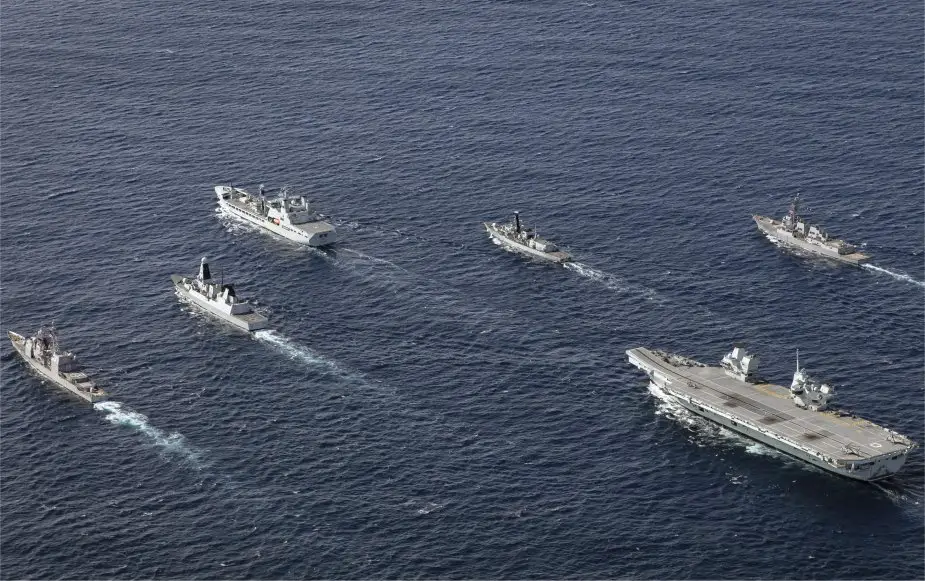Breaking news
UK Carrier Strike Group deployment heading for the Indo Pacific.
According to information published by the UK Navy on April 27, 2021, led by HMS Queen Elizabeth, the task group will visit 40 nations including India, Japan, Republic of Korea and Singapore in a deployment covering 26,000 nautical miles.
Follow Navy Recognition on Google News at this link
 HMS Queen Elizabeth in formation with her Carrier Strike Group during Exercise Westlant 19 (Picture source: UK Ministry of Defense)
HMS Queen Elizabeth in formation with her Carrier Strike Group during Exercise Westlant 19 (Picture source: UK Ministry of Defense)
The group will also join up and take part in exercises with French carrier FS Charles De Gaulle in the Mediterranean as well as navies and aircraft from allies such as the US, Canada, Denmark, Greece, Israel, Italy, Japan and the UAE.
While in the Pacific, ships from the Carrier Strike Group will mark the 50th anniversary of the Five Powers Defence Agreement between Malaysia, Singapore, Australia, New Zealand and the UK by taking part in Exercise Bersama Lima.
Joining HMS Queen Elizabeth on her maiden deployment are destroyers HMS Diamond and Defender; frigates HMS Richmond and Kent; an Astute-class submarine in support below the waves; and Royal Fleet Auxiliary support ships RFA Fort Victoria and RFA Tidespring.
More than 30 aircraft will also embark across the task group including F-35 jets from 617 Squadron, the Dambusters, and the US Marine Corps’ VMFA-211; Wildcat helicopters from 815 Naval Air Squadron and Merlin helicopters from 820 and 845 Naval Air Squadrons.
Royal Marines from 42 Commando will also deploy with the carrier.
Dutch frigate HNLMS Evertsen and American Arleigh Burke destroyer USS The Sullivans are also part of the strike group.
The forthcoming deployment is intended to bolster already deep defence partnerships in the Pacific region, where the UK is committed to a more enduring regional defence and security presence.
Events in Singapore, the Republic of Korea, Japan and India will provide the opportunity to strengthen security relationships, tighten political ties and support UK exports and the nation’s International Trade agenda.
The Carrier Strike Group will participate in NATO exercises such as Exercise Steadfast Defender, and provide support to NATO Operation Sea Guardian and security operations in the Black Sea.
In total, units from the group visit more than 40 countries and undertake in excess of 70 engagements, visits, air exercises and operations.
The HMS Queen Elizabeth is the lead ship of the two Queen Elizabeth-class aircraft carriers in service with the British Navy. The ship was launched on 21 December 2017, and was commissioned on 10 December 2019. She has an overall length of 280 meters (920 ft), a width at deck level of 70 meters (230 ft), a height of 56 meters (184 ft), a draught of 11 meters (36 ft), and a range of 10,000 nautical miles (12,000 mi; 19,000 km).
The propulsion of the HMS Queen Elizabeth consists of two Rolls-Royce Marine Trent MT30 36 MW (48,000 hp) gas turbine engine and four Wärtsilä 38 marine diesel engines. The ship can reach a top speed of 25 knots (46 km/h; 29 mph). The ship has a crew of 679 people that not include the air elements. for its self-protection, the aircraft carrier is armed with three Phalanx CIWS (Close-In Weapon Systems), four 30-mm DS30M Mk2 automatic cannons, and six Miniguns.
The HMS Queen Elizabeth is deployed with up to two operational Lightning fighter aircraft squadrons with a maximum of 24 F-35Bs short takeoff/vertical landing (STOVL) fighter aircraft and the ability to operate 36 F-35B in extreme circumstances. Fourteen Merlin HM2 will be available with typically nine in anti-submarine configuration and four or five with Crowsnest for airborne early warning.




























